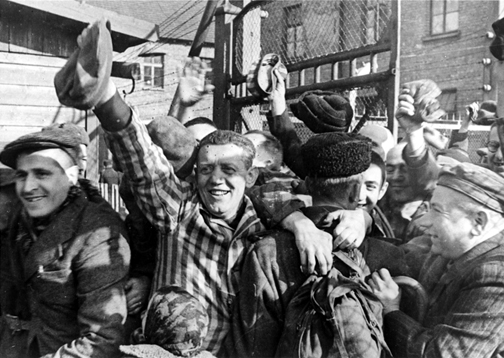
Auschwitz-Birkenau |
||
|

|
The Auschwitz main camp, the Birkenau death camp and the Monowitz labor camp were liberated by soldiers of the Soviet Union in the First Army of the Ukrainian Front, under the command of Marshal Koniev, on January 27, 1945. The photo above shows a few of the survivors in the main Auschwitz camp, standing near the "Arbeit Macht Frei" gate. One prisoner has his arms around the neck of a Soviet soldier who is wearing a fur hat. This photo was staged in early February, 1945 after the liberation, as the liberators did not have cameras with them. 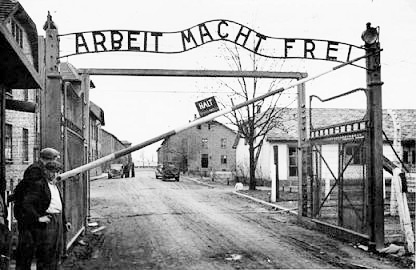 On January 18, 1945, the three Auschwitz camps, called Auschwitz I, II and III, and the 40 satellite camps had been abandoned by the Germans. The gassing of the Jews at Auschwitz II, also known as Birkenau, had stopped at the end of October 1944. The evacuation of the Birkenau survivors to other concentration camps in the West had already begun in early October. Anne Frank and her sister Margo were on one of the first transports out of Auschwitz, which took them to Bergen-Belsen, where they both died of typhus. Aerial photos taken by the Allies showed that the roofs of crematoria buildings Krema II and Krema III at Birkenau had been removed in November 1944, so that the cremation ovens could be removed by cranes. 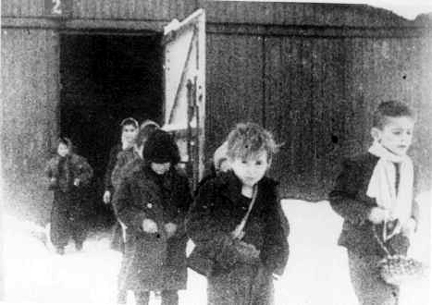 After the three Auschwitz camps were liberated, the survivors were on their own. Unlike the concentration camps in Germany, where the liberated prisoners remained in the camps as Displaced Persons and were cared for by the Americans or the British, the Auschwitz-Birkenau prisoners from 29 countries were released to find their own way home. Primo Levi was one of the survivors who wrote a book, later made into a movie, about his long journey home to Italy which took him many months. He describes how the Jewish prisoners were greeted with hostility in every country along the way. Binjamin Wilkomirski also describes this in his book, Fragments: "And the people outside the camp, in the countryside and the nearby town -- they didn't celebrate when they saw us." In a film produced by the Auschwitz Museum, which I purchased in a bookstore there, one of the museum administrators said that he had heard that the camp was not liberated, but rather "it was happened upon by the Red Army when they were marching by." He also mentioned that some people have said that the survivors liberated themselves. Binjamin Wilkomirski, who claimed to be a child survivor of Auschwitz, wrote in his book, "Fragments," that there was no liberation. "We just ran away without permission," he wrote. "No joyous celebration. I never heard the word 'liberation' back then, I didn't even know there was such a word." According to Danuta Czech, who wrote a book entitled "Auschwitz Kalendarium," the total count from the last roll call on January 17, 1945 was 67,012 prisoners in all three Auschwitz camps. According to Otto Frank, the father of Anne Frank, the prisoners were given a choice between staying in the camps until the Soviet troops arrived or going on a 50-kilometer fast hike through two feet of snow to the border of the old German Reich where they would be put on trains and taken to camps in Germany. This was a "death march" with those who couldn't keep up being shot and left alongside the road, including SS guards, according to a survivor. Those who were too young, too old or too sick to march were left behind. The VIP prisoners, a group of famous scientists and intellectuals, were also left behind. Elie Wiesel, the most famous survivor of the Holocaust, was in a hospital at Monowitz, recovering from an operation on his foot, when he chose to join the march out of the camp, and eventually ended up at the Buchenwald camp. In his book entitled "Night," Elie Wiesel wrote the following regarding his decision to join the Germans on the march out of Auschwitz: The choice was in our hands. For once we could decide our fate for ourselves. We could both stay in the hospital, where I could, thanks to my doctor, get him (his father) entered as a patient or nurse. Or else we could follow the others. "Well, what shall we do, father?" He was silent. "Let's be evacuated with the others," I told him. 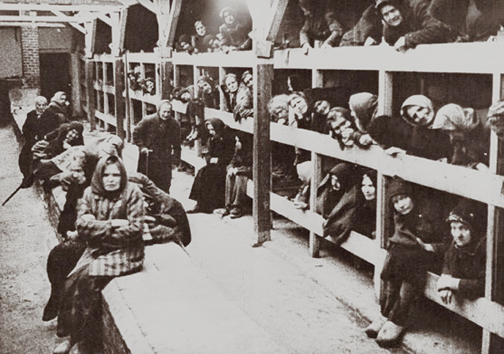 Around 60,000 prisoners chose to go with the Germans and many of them didn't survive the march. Those who couldn't keep up were shot and their bodies were left in the snow. Many more died on the trains taking them to Dachau, Buchenwald, Bergen-Belsen or Mauthausen. Otto Frank chose to stay in the camp and he survived. There were 611 children in the Birkenau camp who stayed behind when the camp was evacuated on January 18, 1945. According to Danuta Czech, the evacuation began in the early morning hours when 500 women with children were escorted out of the camp by SS guards. They reached Wodzislaw on January 21st. The men arrived the next day and all were loaded onto open box cars and taken to Germany. The prisoners at Monowitz and all the prisoners in the sub-camps marched to the four concentration camps at Gleiwitz near the German border, arriving on January 21st. They were then taken on trains to Buchenwald, Dachau, Sachsenhausen or Mauthausen. There were 4,428 women and girls and 169 boys who stayed behind. Around 2,000 prisoners were left behind in the men's camp at Birkenau; there were around 1250 men in the main camp who did not join the march out of the camp and 850 who chose to stay behind at Monowitz. Auschwitz was not the first Nazi extermination camp to be liberated. That distinction belongs to Majdanek, a camp that was located in a suburb of the city of Lublin in eastern Poland. The first gas chambers to be seen by anyone in the outside world were at Majdanek, which Soviet soldiers entered on July 23, 1944. The first report, given by the Soviet Union, was that 1.7 million people had been murdered at Majdanek in 7 gas chambers, using Zyklon-B. At the Nuremberg International Military Tribunal, the Soviet Union charged that the Nazi war criminals had killed 1.5 million people at Majdanek. Later, it was learned that 4 of the Majdanek gas chambers had been used for disinfecting the clothing, which had been brought to Majdanek from the three Aktion Reinhard camps, called Treblinka, Sobibor and Belzec. The official web site of the Auschwitz Museum now says that it has been established that 59,000 Jews were murdered at Majdanek. When the soldiers of the Red Army of the Soviet Union arrived at Auschwitz on January 27, 1945, they were expecting to find more gas chambers; the gassing of the Jews had been common knowledge since June 1942 when the news was first broadcast over the radio by the BBC. What they found was the ruins of four large gas chambers where around one million Jews had been gassed. The Nazis had attempted to destroy the evidence of the genocide of the Jews, but had left behind at least 1,200 survivors at the Auschwitz main camp and 5,800 survivors at Birkenau, including 611 children, who were able to tell the liberators about the monstrous crimes that had been perpetrated at Auschwitz-Birkenau. The day that Auschwitz was liberated, January 27, 1945, is now an International Day of Commemoration of the Holocaust. 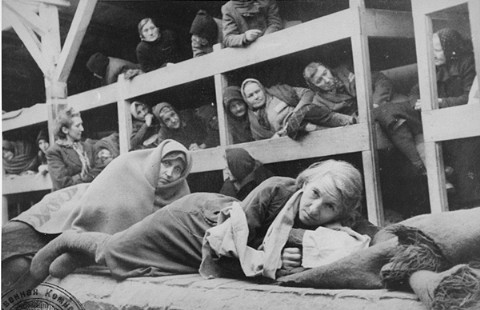 The photograph above is a still shot from a film made by the Soviet Union in February 1945 after Auschwitz-Birkenau was liberated. The photo shows two women in the foreground who are lying on the brick stove down the center of the barrack, as they huddle under blankets trying to keep warm. These women had chosen to stay behind when the camp was evacuated on January 18, 1945. 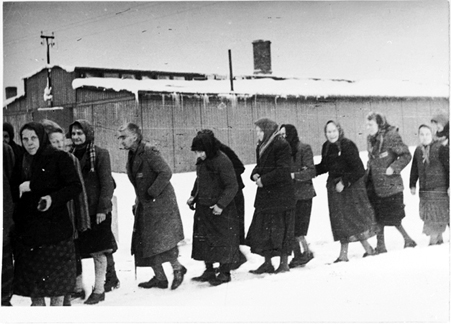 The last roll call, taken on January 17, 1945, showed that there was a total of 16,226 prisoners in the main camp, called Auschwitz I. Of this number, there were 10,030 men and 6,196 women. The Nazi records from the camp were turned over to the International Red Cross Tracing Service by the Soviet Union after the fall of Communism. The total count from the last roll call was 67,012 prisoners in the three Auschwitz camps, according to Danuta Czech's book entitled "Auschwitz Kalendarium." The last roll call showed that there was a total of 15,668 prisoners at Birkenau and four nearby sub-camps. The following figures were published in "Auschwitz Kalendarium": Babitz 159 Before the Nazis abandoned the camp, they burned some of the camp records and also set fire to the clothing warehouses and some of the barracks at Birkenau. The prisoners had named the area where the warehouses were located "Canada" because of the riches contained in these buildings. The warehouses and the barracks were still burning when the Soviet liberators arrived a week later. The photo below is a still photo from a movie made by Henryk Makarewicz, a soldier in the Polish Berlin Army, immediately after the camp was liberated.  A few dead bodies were found stored in a shed at the Birkenau camp. The crematorium ovens had been dismantled and removed from the camp in November 1944.  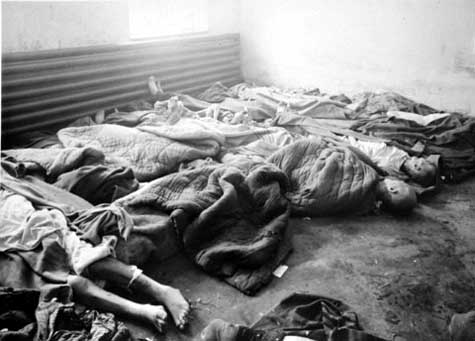  The photograph below is a still shot from a documentary film made by the Soviet Union after the liberation; it shows the burial of inmates who died after the liberation of the camp. They had been left behind because they were sick, and even with the best medical care by the Russian doctors, they could not be saved. 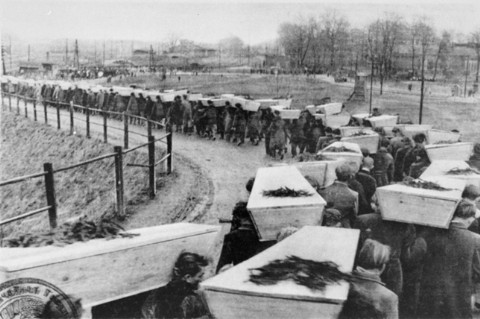 After the camp was liberated, these same barracks in Birkenau were used to house German Prisoners of War captured by the Soviet Union. A year later, the Birkeanu camp was empty; some of the German POWs had been released and others had been marched into Russia to other camps where they became slave laborers, some for as long as 10 years, in the rebuilding of the Soviet Union, which had suffered a lot of war damage. Newspaper article about the liberation of Auschwitz ContinueDeath StatisticsHistory of AuschwitzAuschwitz II - aka BirkenauSelections for gas chamber or laborAuschwitz III - aka MonowitzMonowitz gas chamber?HomeThis page was last updated on January 04, 2010
|